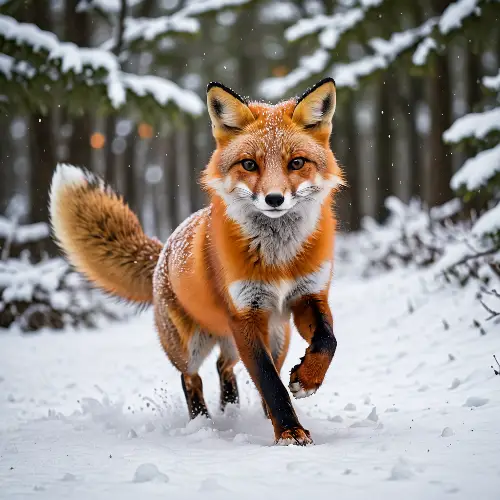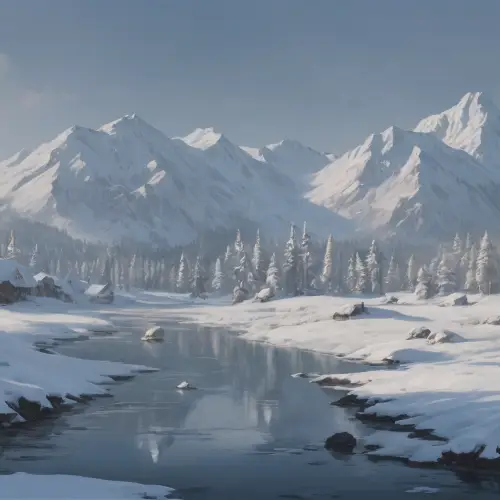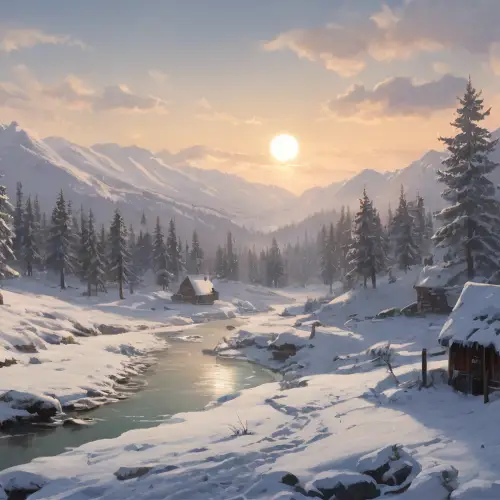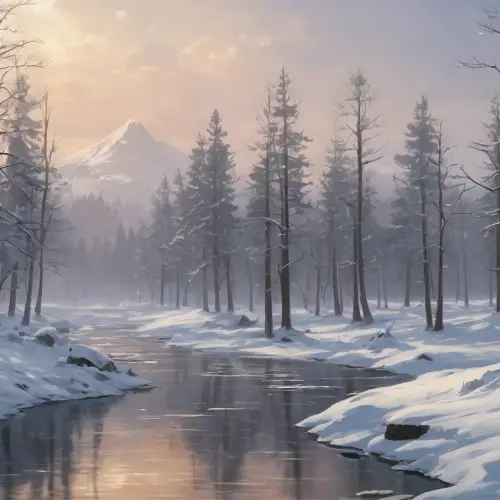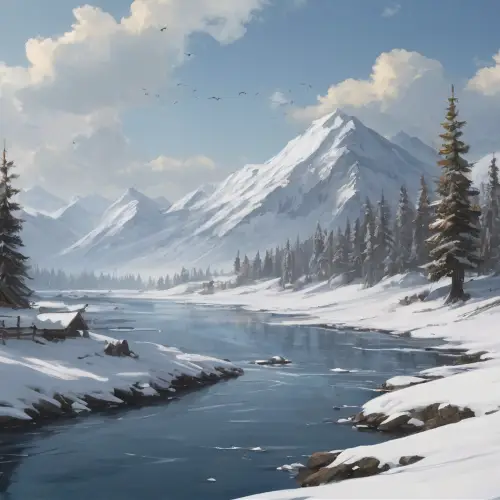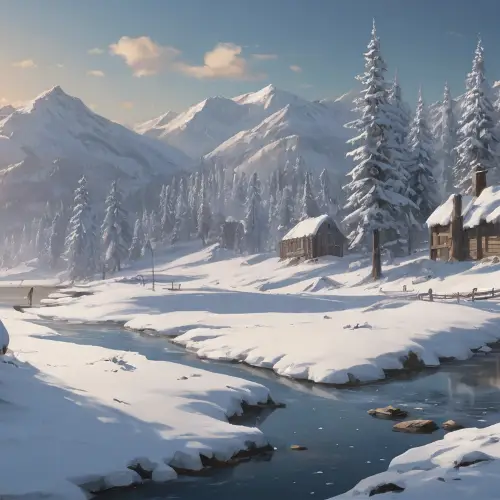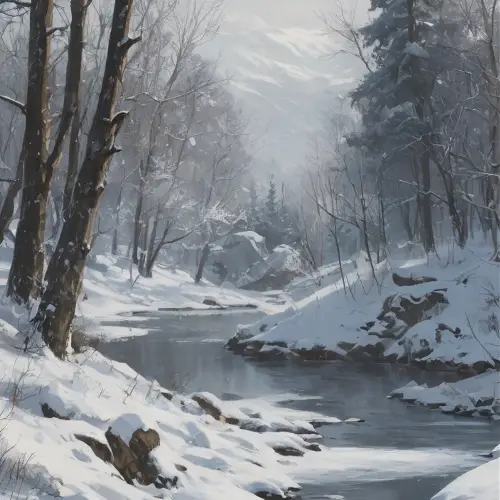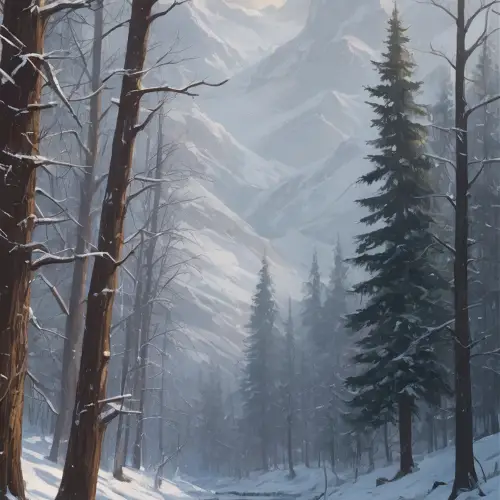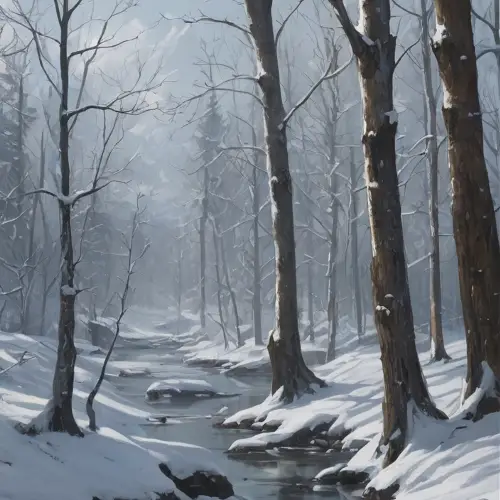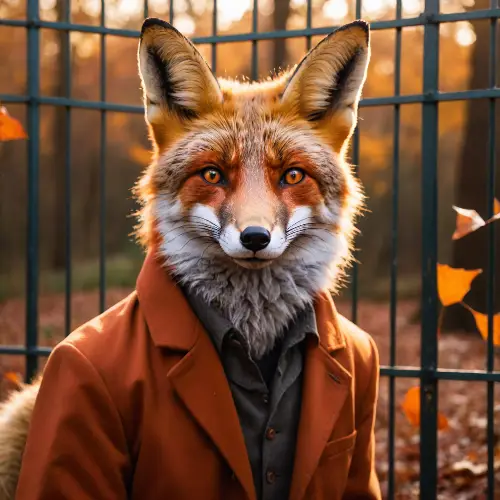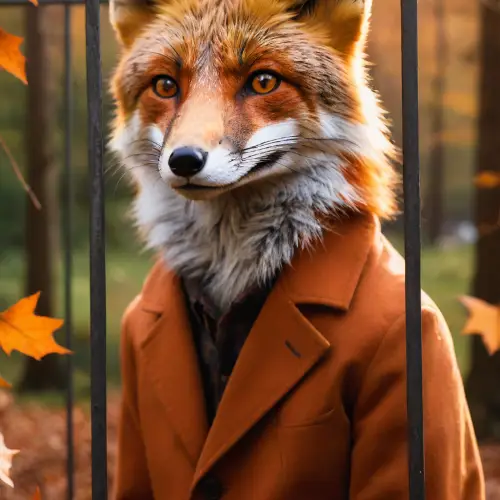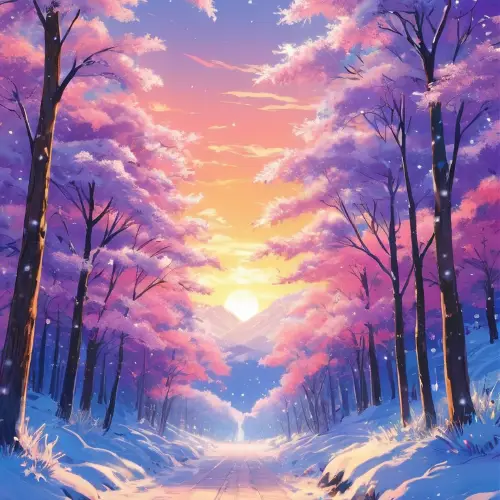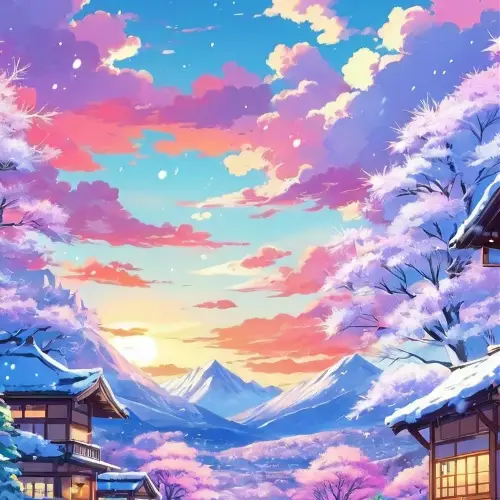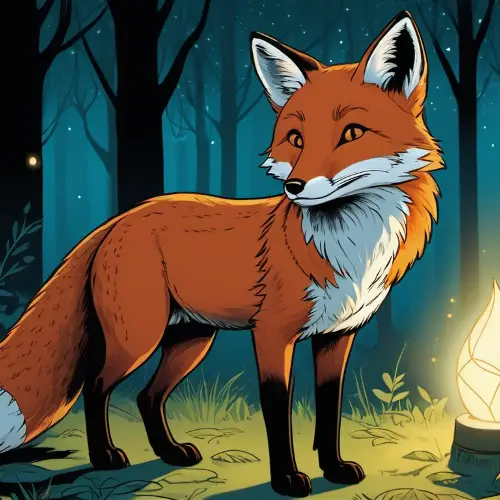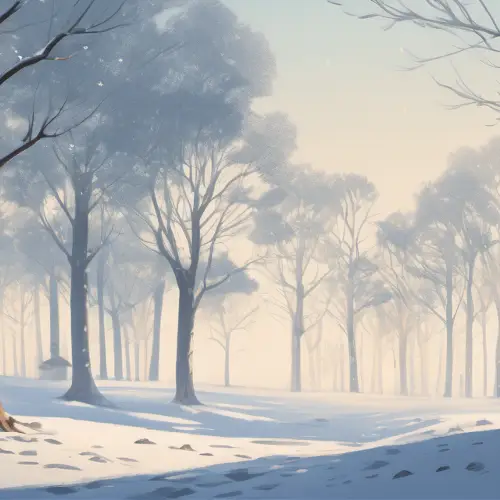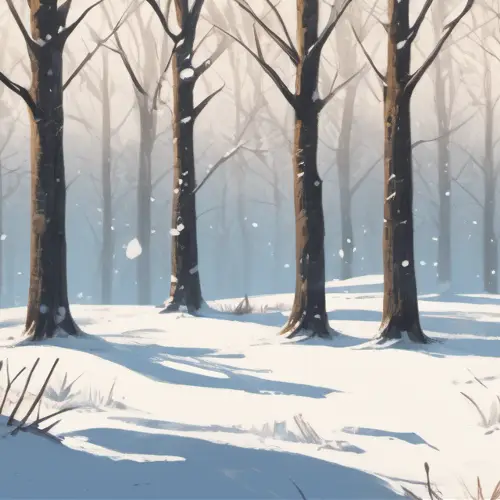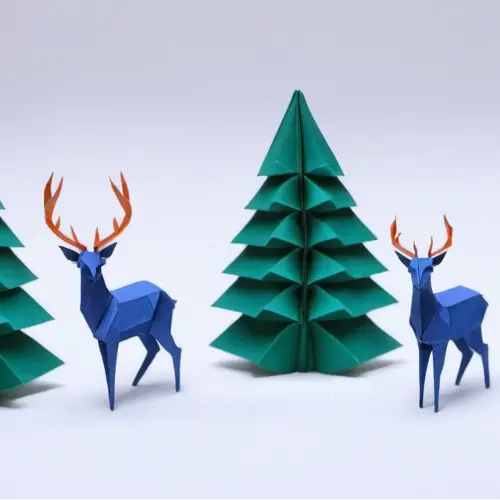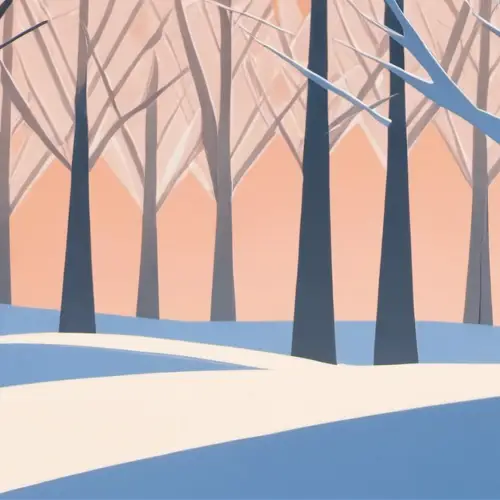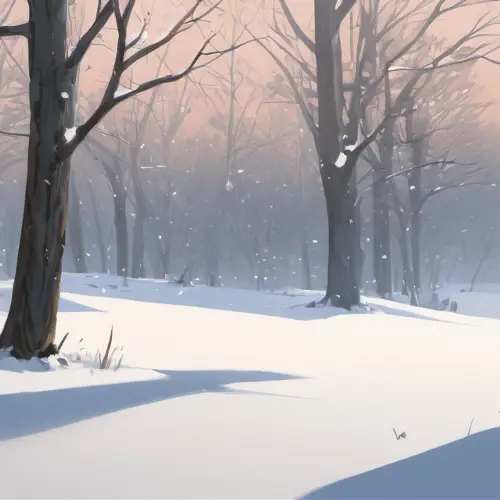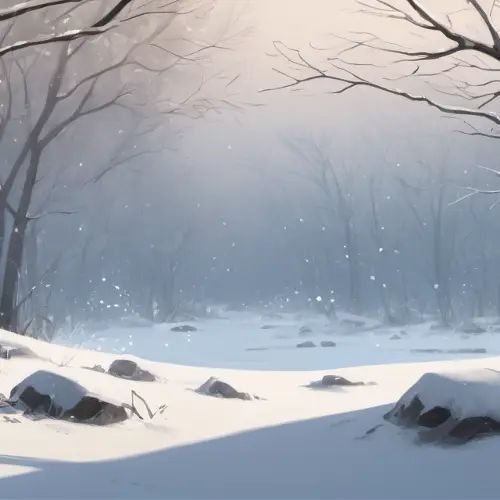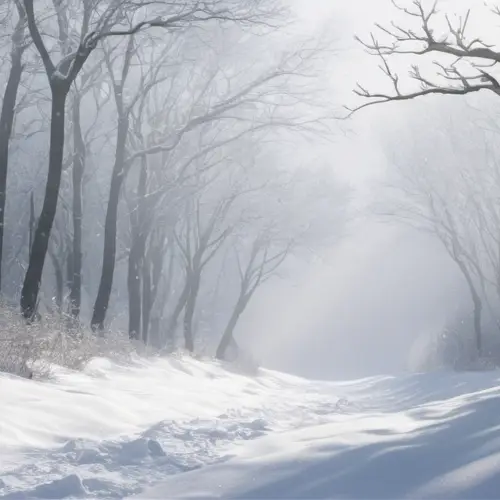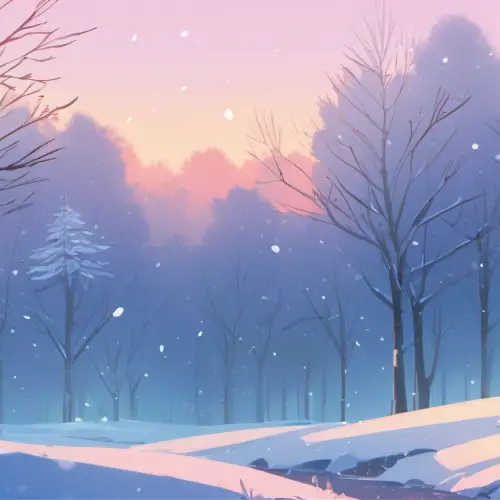In a snowy, icy landscape, a fox, looking cold and hungry, wanders near a road beside a forest. The road stretches into the distance where a carriage can be barely seen in the background. The scene is depicted in a realistic style, capturing the winter atmosphere with details like snow-covered trees, a chilly blue sky, and the fox's fur fluffed up against the cold.
More Like This
In a snowy, icy landscape, a fox, looking cold and hungry, wanders near a road beside a forest. The road stretches into the distance where a carriage can be barely seen in the background. The scene is depicted in a realistic style, capturing the winter atmosphere with details like snow-covered trees, a chilly blue sky, and the fox's fur fluffed up against the cold.
A cute white fox and a little girl are standing knee-deep in snow on a rural street in winter,they are very happy,satisfied, it is snowing,soft light,hyperrealistic,super-expansion,complex details,taken with a Canon EOS 850 body camera,real photo
A cute white fox and a little girl are standing knee-deep in snow on a rural street in winter,they are very happy,satisfied, it is snowing,soft light,hyperrealistic,super-expansion,complex details,taken with a Canon EOS 850 body camera,real photo
A cute white fox and a little girl are standing knee-deep in snow on a rural street in winter,they are very happy,satisfied, it is snowing,soft light,hyperrealistic,super-expansion,complex details,taken with a Canon EOS 850 body camera,real photo
portrait of a white spirt wolf fox with antlers epic fantasy creature landscape of a mystic forest
portrait of a white spirt wolf fox with antlers epic fantasy creature landscape of a mystic forest
In the heart of a Japanese alley, a woman in her thirties walks bundled up in winter attire. She wears a not-too-short skirt, paired with a coat and a red scarf. Her pointed boots crunch through the snow as she navigates the chilly midwinter nights. Beside her, stray cats huddle, feeling the cold. The woman blows warm breath onto her hands for comfort.The scene paints a vivid picture of resilience against the biting cold, where both humans and animals seek solace in the wintry streets. 🌨️❄️🌃
In the heart of a Japanese alley, a woman in her thirties walks bundled up in winter attire. She wears a not-too-short skirt, paired with a coat and a red scarf. Her pointed boots crunch through the snow as she navigates the chilly midwinter nights. Beside her, stray cats huddle, feeling the cold. The woman blows warm breath onto her hands for comfort.The scene paints a vivid picture of resilience against the biting cold, where both humans and animals seek solace in the wintry streets. 🌨️❄️🌃
In the heart of a Japanese alley, a woman in her thirties walks bundled up in winter attire. She wears a not-too-short skirt, paired with a coat and a red scarf. Her pointed boots crunch through the snow as she navigates the chilly midwinter nights. Beside her, stray cats huddle, feeling the cold. The woman blows warm breath onto her hands for comfort.The scene paints a vivid picture of resilience against the biting cold, where both humans and animals seek solace in the wintry streets. 🌨️❄️🌃
The image depicts a fox with a vibrant orange coat and piercing eyes. The fox is inside a metal cage, and the focus is on its face and upper body. Its ears are pricked up, and it appears to be looking slightly to the side with a calm but attentive expression. The background is out of focus, but it seems to be a forest or woodland area with trees and fallen leaves, suggesting it might be autumn. The lighting is warm, indicating that the photo was taken during the golden hour, which highlights the rich colors of the fox's fur.
The image depicts a fox with a vibrant orange coat and piercing eyes. The fox is inside a metal cage, and the focus is on its face and upper body. Its ears are pricked up, and it appears to be looking slightly to the side with a calm but attentive expression. The background is out of focus, but it seems to be a forest or woodland area with trees and fallen leaves, suggesting it might be autumn. The lighting is warm, indicating that the photo was taken during the golden hour, which highlights the rich colors of the fox's fur.
Winter landscape, mountains in the background, forest, a lot of snow, sunlight, a path stretching into the distance, trees in the foreground
Winter landscape, mountains in the background, forest, a lot of snow, sunlight, a path stretching into the distance
Illustrate a scene with a small, smart-looking fox in a glowing forest. The fox should appear curious and fascinated, looking intently at the glowing trees around it. The environment should be enchanting, with soft moonlight filtering through the trees
White fox, ancient style, realistic, photographic style, background of snow-capped mountains, 32K ultra HD
White fox, ancient style, realistic, photographic style, background of snow-capped mountains, 32K ultra HD
To create a visual representation of a \"winter forest,\" we'll consider conveying the essence of a forest during the wintertime. This entails depicting elements such as bare trees, snow, cool color tones, and perhaps wildlife or signs of life that are commonly associated with a forest in the winter season. Here's how you can create this visual representation: Overall Layout: Decide on the perspective of your visual – it could be a landscape view, a close-up of a part of the forest, or an abstract representation. Sketch or outline the basic shapes and areas where you will place the main elements such as trees, snowdrifts, and the sky. Trees: Draw or use images of trees with bare branches to represent deciduous trees in their dormant state. For evergreen trees, indicate their shapes with fuller, triangular forms to contrast with the bare branches. Use white or light gray to add touches of snow on the branches. Snow: Depict snow on the ground with curving lines to represent undulating snowdrifts. Use a bright white or slightly blue-tinted white for the snow to convey chilliness. Consider adding subtle shadows to the snow to create depth, using light blue or gray. Color Palette: Utilize cool tones such as blues, whites, and grays to convey the cold temperature. If there's a sunrise or sunset, you may introduce warmer hues like pink or orange in the sky, but keep it subtle. Wildlife and Details: If you want to showcase life in the winter forest, consider adding animals such as deer, rabbits, or birds. You can also add finer details like animal tracks in the snow, icicles hanging from branches, or a frozen stream. Atmosphere: Create a sense of atmosphere by adding light fog or mist to illustrate cold winter air, using light grey or soft white washes. To depict a time of day, consider the position and color of light; soft morning light, the gray overcast of midday, or the golden hues of a setting sun. Finishing Touches: Review your visual to ensure a balanced composition, and add any final details or adjustments to enhance realism or abstraction, depending on your style. Consider adding a slight vignette effect or framing with tree branches at the edges to draw focus into the center of the scene.
To create a visual representation of a \"winter forest,\" we'll consider conveying the essence of a forest during the wintertime. This entails depicting elements such as bare trees, snow, cool color tones, and perhaps wildlife or signs of life that are commonly associated with a forest in the winter season. Here's how you can create this visual representation: Overall Layout: Decide on the perspective of your visual – it could be a landscape view, a close-up of a part of the forest, or an abstract representation. Sketch or outline the basic shapes and areas where you will place the main elements such as trees, snowdrifts, and the sky. Trees: Draw or use images of trees with bare branches to represent deciduous trees in their dormant state. For evergreen trees, indicate their shapes with fuller, triangular forms to contrast with the bare branches. Use white or light gray to add touches of snow on the branches. Snow: Depict snow on the ground with curving lines to represent undulating snowdrifts. Use a bright white or slightly blue-tinted white for the snow to convey chilliness. Consider adding subtle shadows to the snow to create depth, using light blue or gray. Color Palette: Utilize cool tones such as blues, whites, and grays to convey the cold temperature. If there's a sunrise or sunset, you may introduce warmer hues like pink or orange in the sky, but keep it subtle. Wildlife and Details: If you want to showcase life in the winter forest, consider adding animals such as deer, rabbits, or birds. You can also add finer details like animal tracks in the snow, icicles hanging from branches, or a frozen stream. Atmosphere: Create a sense of atmosphere by adding light fog or mist to illustrate cold winter air, using light grey or soft white washes. To depict a time of day, consider the position and color of light; soft morning light, the gray overcast of midday, or the golden hues of a setting sun. Finishing Touches: Review your visual to ensure a balanced composition, and add any final details or adjustments to enhance realism or abstraction, depending on your style. Consider adding a slight vignette effect or framing with tree branches at the edges to draw focus into the center of the scene.
To create a visual representation of a \"winter forest,\" we'll consider conveying the essence of a forest during the wintertime. This entails depicting elements such as bare trees, snow, cool color tones, and perhaps wildlife or signs of life that are commonly associated with a forest in the winter season. Here's how you can create this visual representation: Overall Layout: Decide on the perspective of your visual – it could be a landscape view, a close-up of a part of the forest, or an abstract representation. Sketch or outline the basic shapes and areas where you will place the main elements such as trees, snowdrifts, and the sky. Trees: Draw or use images of trees with bare branches to represent deciduous trees in their dormant state. For evergreen trees, indicate their shapes with fuller, triangular forms to contrast with the bare branches. Use white or light gray to add touches of snow on the branches. Snow: Depict snow on the ground with curving lines to represent undulating snowdrifts. Use a bright white or slightly blue-tinted white for the snow to convey chilliness. Consider adding subtle shadows to the snow to create depth, using light blue or gray. Color Palette: Utilize cool tones such as blues, whites, and grays to convey the cold temperature. If there's a sunrise or sunset, you may introduce warmer hues like pink or orange in the sky, but keep it subtle. Wildlife and Details: If you want to showcase life in the winter forest, consider adding animals such as deer, rabbits, or birds. You can also add finer details like animal tracks in the snow, icicles hanging from branches, or a frozen stream. Atmosphere: Create a sense of atmosphere by adding light fog or mist to illustrate cold winter air, using light grey or soft white washes. To depict a time of day, consider the position and color of light; soft morning light, the gray overcast of midday, or the golden hues of a setting sun. Finishing Touches: Review your visual to ensure a balanced composition, and add any final details or adjustments to enhance realism or abstraction, depending on your style. Consider adding a slight vignette effect or framing with tree branches at the edges to draw focus into the center of the scene.
To create a visual representation of a \"winter forest,\" we'll consider conveying the essence of a forest during the wintertime. This entails depicting elements such as bare trees, snow, cool color tones, and perhaps wildlife or signs of life that are commonly associated with a forest in the winter season. Here's how you can create this visual representation: Overall Layout: Decide on the perspective of your visual – it could be a landscape view, a close-up of a part of the forest, or an abstract representation. Sketch or outline the basic shapes and areas where you will place the main elements such as trees, snowdrifts, and the sky. Trees: Draw or use images of trees with bare branches to represent deciduous trees in their dormant state. For evergreen trees, indicate their shapes with fuller, triangular forms to contrast with the bare branches. Use white or light gray to add touches of snow on the branches. Snow: Depict snow on the ground with curving lines to represent undulating snowdrifts. Use a bright white or slightly blue-tinted white for the snow to convey chilliness. Consider adding subtle shadows to the snow to create depth, using light blue or gray. Color Palette: Utilize cool tones such as blues, whites, and grays to convey the cold temperature. If there's a sunrise or sunset, you may introduce warmer hues like pink or orange in the sky, but keep it subtle. Wildlife and Details: If you want to showcase life in the winter forest, consider adding animals such as deer, rabbits, or birds. You can also add finer details like animal tracks in the snow, icicles hanging from branches, or a frozen stream. Atmosphere: Create a sense of atmosphere by adding light fog or mist to illustrate cold winter air, using light grey or soft white washes. To depict a time of day, consider the position and color of light; soft morning light, the gray overcast of midday, or the golden hues of a setting sun. Finishing Touches: Review your visual to ensure a balanced composition, and add any final details or adjustments to enhance realism or abstraction, depending on your style. Consider adding a slight vignette effect or framing with tree branches at the edges to draw focus into the center of the scene. To bring this visualization to life, you can use various mediums such as drawing by hand, digital illustration, or even arranging a collage with mixed materials. Consider also the context in which this visual will be used, as that might dictate the level of detail and stylization you apply to your representation of the winter forest.
To create a visual representation of a \"winter forest,\" we'll consider conveying the essence of a forest during the wintertime. This entails depicting elements such as bare trees, snow, cool color tones, and perhaps wildlife or signs of life that are commonly associated with a forest in the winter season. Here's how you can create this visual representation: Overall Layout: Decide on the perspective of your visual – it could be a landscape view, a close-up of a part of the forest, or an abstract representation. Sketch or outline the basic shapes and areas where you will place the main elements such as trees, snowdrifts, and the sky. Trees: Draw or use images of trees with bare branches to represent deciduous trees in their dormant state. For evergreen trees, indicate their shapes with fuller, triangular forms to contrast with the bare branches. Use white or light gray to add touches of snow on the branches. Snow: Depict snow on the ground with curving lines to represent undulating snowdrifts. Use a bright white or slightly blue-tinted white for the snow to convey chilliness. Consider adding subtle shadows to the snow to create depth, using light blue or gray. Color Palette: Utilize cool tones such as blues, whites, and grays to convey the cold temperature. If there's a sunrise or sunset, you may introduce warmer hues like pink or orange in the sky, but keep it subtle. Wildlife and Details: If you want to showcase life in the winter forest, consider adding animals such as deer, rabbits, or birds. You can also add finer details like animal tracks in the snow, icicles hanging from branches, or a frozen stream. Atmosphere: Create a sense of atmosphere by adding light fog or mist to illustrate cold winter air, using light grey or soft white washes. To depict a time of day, consider the position and color of light; soft morning light, the gray overcast of midday, or the golden hues of a setting sun. Finishing Touches: Review your visual to ensure a balanced composition, and add any final details or adjustments to enhance realism or abstraction, depending on your style. Consider adding a slight vignette effect or framing with tree branches at the edges to draw focus into the center of the scene.
White fox, cute, ancient style, realistic, photographic style, background of snow-capped mountains, 32K ultra HD
cute kawaii vector illustration of a orange-color foxplushie (wearing a scarf) its eyes closed and standing on two legs, in a snowing wintry landscape, holding a wrapped present
cute kawaii vector illustration of a orange-color foxplushie (wearing a scarf) its eyes closed and standing on two legs, in a snowing wintry landscape, holding a wrapped present
cute kawaii vector illustration of a orange-color foxplushie (wearing a scarf) its eyes closed and standing on two legs, in a snowing wintry landscape, holding a wrapped present
cute kawaii vector illustration of a orange-color foxplushie (wearing a scarf) its eyes closed and standing on two legs, in a snowing wintry landscape, holding a wrapped present
cute kawaii vector illustration of a orange-color foxplushie (wearing a scarf) its eyes closed and standing on two legs, in a snowing wintry landscape, holding a wrapped present
cute kawaii vector illustration of a orange-color foxplushie (wearing a scarf) its eyes closed and standing on two legs, in a snowing wintry landscape, holding a wrapped present





